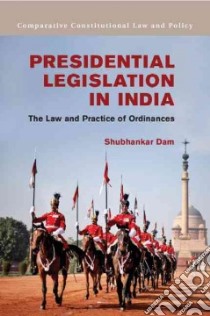- Libreria
- >
- Libri in lingua
- >
Presidential Legislation in India - 9781107039711
Un libro in lingua di Shubhankar Dam edito da Cambridge Univ Pr, 2013
- € 78.80
- Il prezzo è variabile in funzione del cambio della valuta d’origine
"The legislative process in India's parliamentary system, like elsewhere, is a shared exercise: the executive and the legislature partake in it. Ordinarily, proposals for legislation originate in the cabinet. If the cabinet decides that a law is necessary, a bill is drafted, on occasions, with external inputs. After it is introduced in the two houses, the bill goes through several 'readings', committee hearings and amendments. The final draft is debated and voted on. If a bill secures the requisite majority in both houses, it is sent to the president for assent, upon which the bill becomes an Act. Parliament, in this formal view, is central to the legislative process, and legislation are products of among other things a rational-legal scrutiny and vote. In practice, parliament is less than central; the legislative process rarely confirms to the constitutional ideal type. Take, for example, political parties and their influence on the legislative process. The party to which a government belongs can have adisproportionate say in policy and legislative matters. Indeed, depending on the personalities involved, legislative proposals may even originate and take shape in party headquarters. Or consider a coalition government. A cabinet's decision to introduce a bill may be evidence of compulsion, not necessity. It may be a price for keeping the coalition together or a political maneuvering to secure new allies. Also, consider the influence of non-representative actors and their ability to direct legislative proposals"--
Informazioni bibliografiche
- Titolo del Libro in lingua: Presidential Legislation in India
- Sottotitolo: The Law and Practice of Ordinances
- Lingua: English
- Autore: Shubhankar Dam
- Editore: Cambridge Univ Pr
- Collana: Cambridge Univ Pr (Hardcover)
- Data di Pubblicazione: 16 Dicembre '13
- Genere: LAW
- Argomenti : Orders in council Executive orders India LAW / Constitutional. bisacs
- Pagine: 259
- ISBN-10: 1107039711
- EAN-13: 9781107039711


